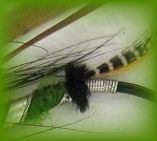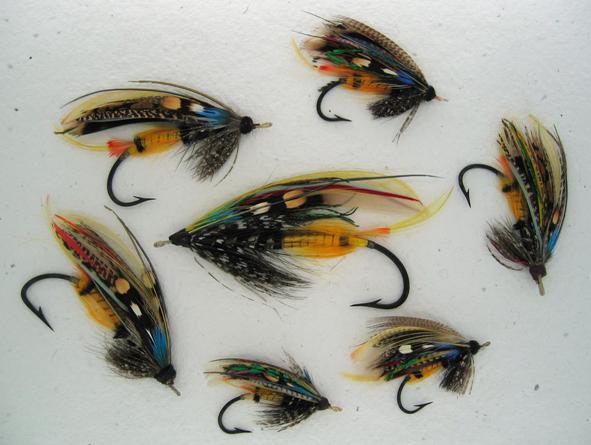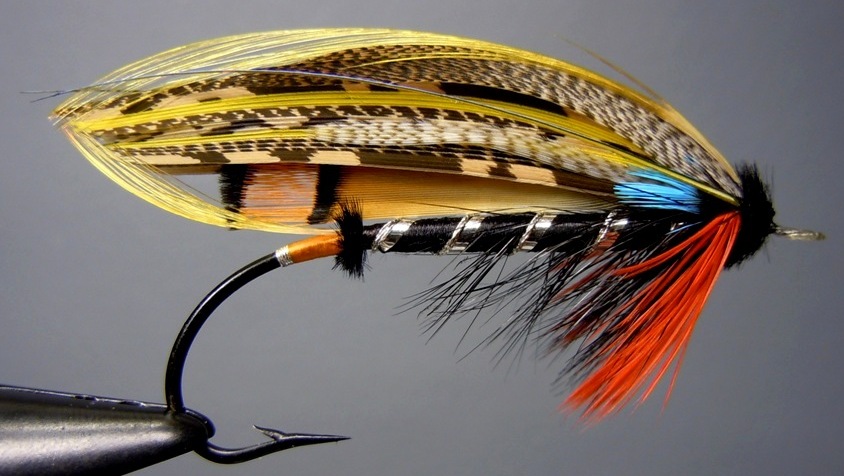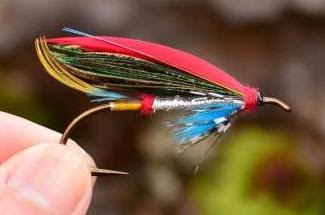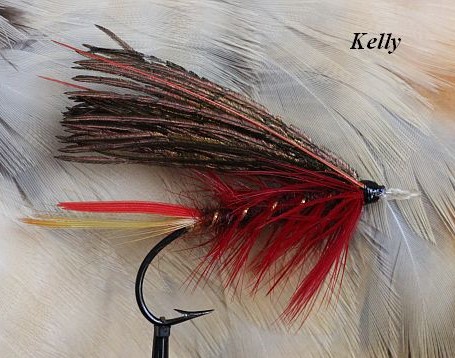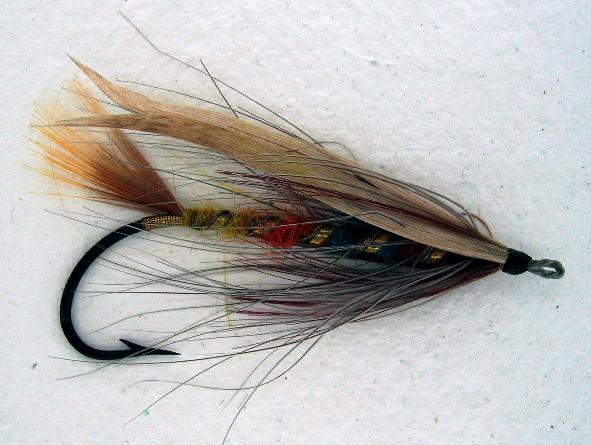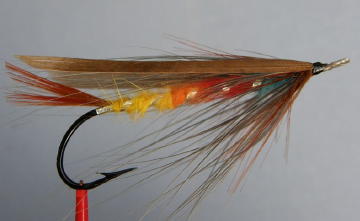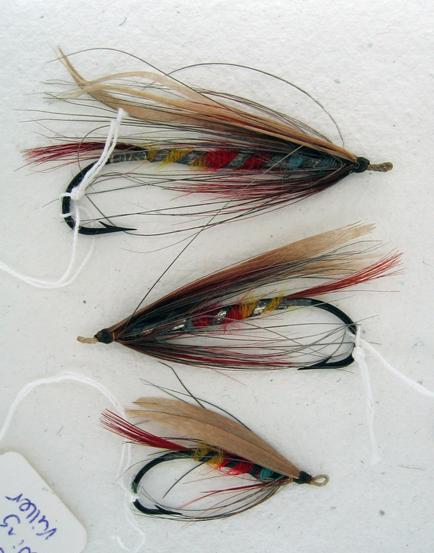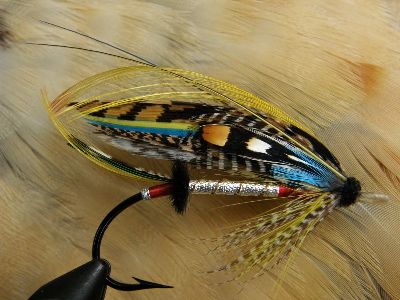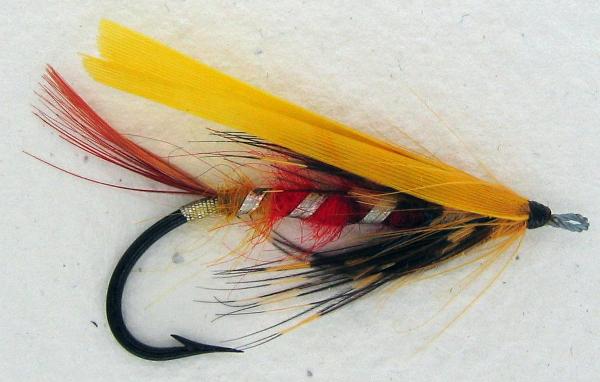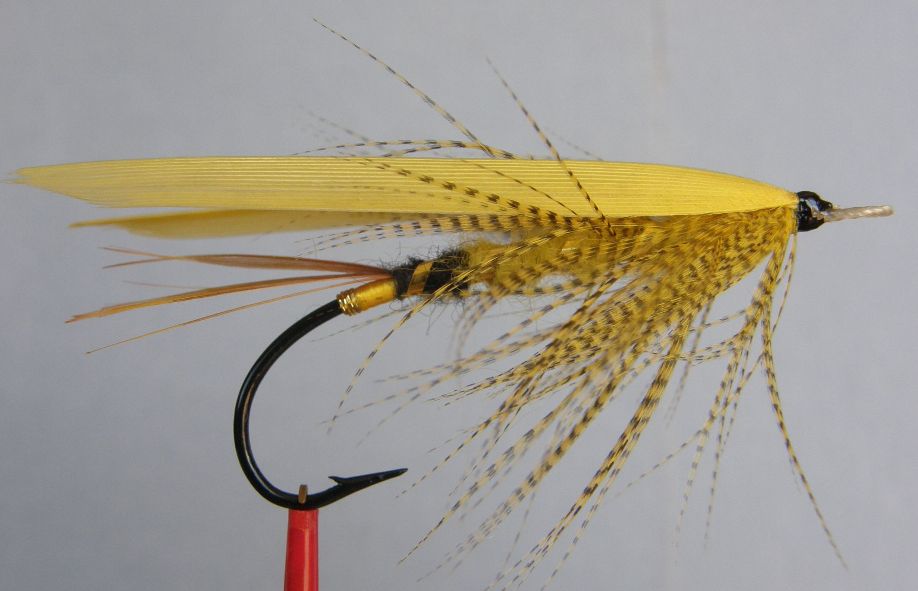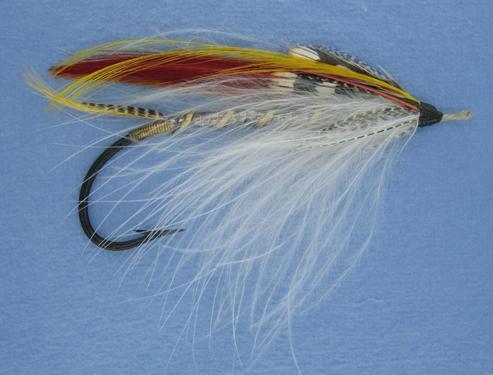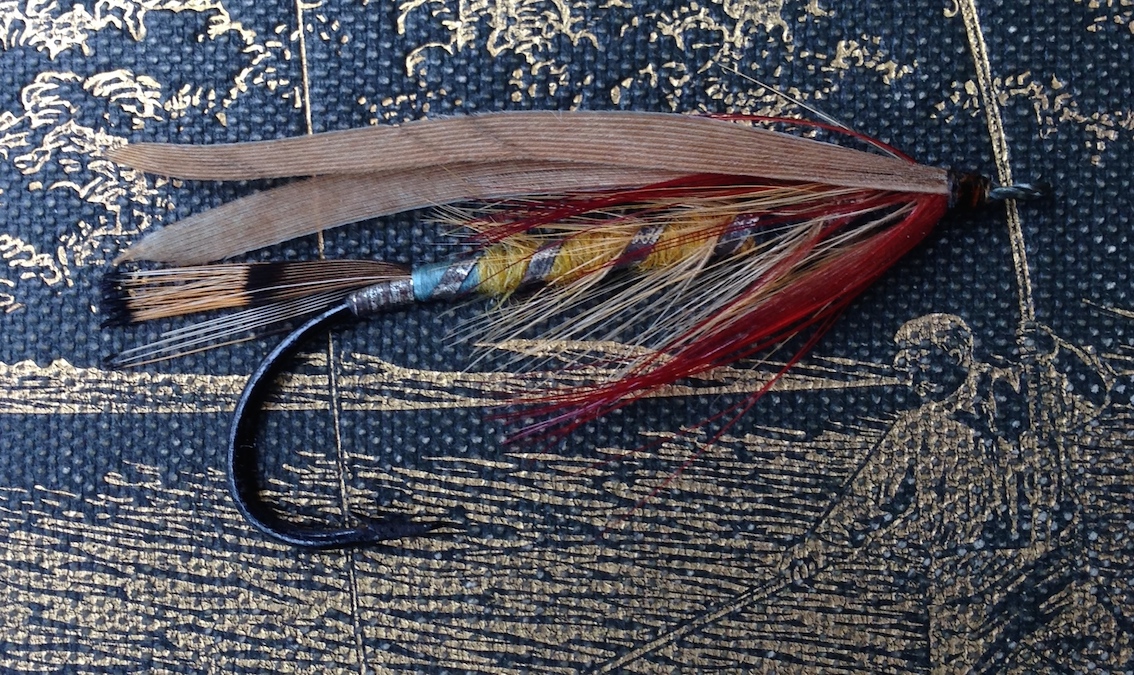 |
 |
|
Flies on this page, Jock Scott, Jockie, Jonah, John Campbell, Kelly, Killer, Brown Winged Killer, Killer (Ythan), Lady Grace, Lady Mary and Lady of the Lake, please scroll down Jock Scott
Not very rare the Jock Scott, but nice when you find them - these are all vintage There are many tales about the invention of the Jock Scott - I guess we will never know the ture story and I'm sure it will be debated for as long as there is an interest in the classic flies. - Here is one that I rather like by one Rev McCallum, who used the core of this piece in three different articles over a period of about 20 years in the Scotsman newspaper. A Hot Half Hour - The Jock Scott, from the Scotsman We join the Reverend just before lunch on a cold November day on “Laying the rod on the benty grass, one crunched one’s way to the top of the bank. A heron was spreading his wide wings on the air; wild duck with outstretched necks were coming at high speed down the river. Someone was near. Perhaps he was a skilful angler who had lured a fish and could name the taking fly. In this hope one trudged up with crickling tread beside troubled waters and behold no man, but across the foam, swirling among the rocks at the lower end of Makerstoun one saw a storied house half-hidden by trees that still kept their red and orange, and the “Jock Scott” darted into the mind. For in that cottage Lord John Scott’s fisherman of like name first busked the famous fly. The date of its birth in 1850. In that year Lord John Scott rented Makerstoun water from Sir Thomas Makdougall Brisbane, laird of Makerstoun at the time. Tho’ autumn was disappointing, there were fish, but anglers could not catch them. The fisherman set himself to devise something new; the result was the Jock Scott, which Kelson has pronounced “the acknowledged king of built-wing flies, fit to reign over his own large circle of admirers.” No one taught the inventor the art he enriched. When a boy just into his teens he began work at Monteviot and with a spare half-crown be bought an Irish fly, which he carefully stripped, and dressed again. Afterwards a gentleman on his return from the East gave him feathers of the Indian crow, jungle cock, and macaw, which are among the twenty-seven items that make up the. Though like nothing in Nature, the markings of the Red Admiral butterfly suggested to his mind the use of jungle cock for the sides of the fly, while for the head he took the hair of his beard, which was black, as he was then but three and thirty years of age. After trying it on the sporting pools of Makerstoun, he gave a pattern to the Duke of Roxburghe and to Mr. Forrest, Kelso, who, being successful with it, christened it “Jock Scott.” Perhaps it was the fact of the busker’s beard being in the fly that led Mr. Forrest to give it his name. At any rate, when the Duchess of Roxburghe heard that it was with a fly dressed with the hair of the Makerstoun fisherman’s beard that His Grace was catching salmon, she drove up to see the inventor and inquire of him the as to the truth of the story. Thus from the first the “Jock Scott” has been a killing fly, and it enjoys a wider reputation than any other to-day. It falls on all rivers in spring and in autumn, in the greyness of morning or before the coming of the evening out of the unknown, but some think it is most effective when the river is small and clear. General Home, using it at Bigham when Tweed when Tweed ran low, killed four fish, one of them 51½ lb, in about 10 minutes on a November day in 1892, and there had been 16 degrees of frost that morning. This, then, was just the day for the Jock Scott, and down there below the foaming jumble was just the place where a big fish might lie when the river is dead low. Going back to the pool, one’s choice of fly thus easily made, one thought of the ups and downs of the inventor because of a mans deceit and a woman’s impulsiveness, and of the after years when in the kindly service of the Earl of Haddington he lived at Langshaw, and seldom dressed a fly or handled a rod, but tended his game, his cows, and his hundreds of roses, till he died in 1893 of an insidious disease in the shooting box, which has the words inscribed in stone over the entrance door - “Utinam hane veris amieis impleam” (would that I could fill this with true friends.) With a double hooked pattern tied to the cast, one waded in again at the neck of the pool, and put the fly beyond the far edge of the broken water, where salmon are want to lie. A few casts and he had it. There was no savage snatch, no sudden dash. The fly stopped, the line straightened. One would have thought him a small fish had he got off the hook at the start, but when he persisted in boring his way to a rock, which he must not reach, one’s opinion of his weight begins to change. Up he ran towards it, right through the rapid water. The line fizzed. When he was near the horrid danger one eased the strain, and, lo! He turned. Then followed that jiggering, those jerky twitches which an angler dislikes so much, but it was in the last 10 minutes when he felt the stones beneath him that the fun “grew fast and furious.” Up and down he lashed and splashed like a hungry sea-lion, but his vigour was his death. The fisherman standing motionless at the edge of the ice soon had him in the net, and, though he bled, he pulled the spring balance down to three stones that night. It was a hot half hour of a very cold day.” Kelson – Land & Waters Cards, c1885 Tag: Silver twist and light yellow silk. Tail: A topping and Indian crow. Butt: Black herl. Body: In two equal sections, the first light yellow silk ribbed with fine silver tinsel, above and below this are placed three or more toucan’s feathers according to the size of the hook, extending slightly beyond the butt and followed with three or four turns of black herl. In the second half we have silk, with a natural black hackle running along it and ribbed with broader silver tinsel (and silver lace on very large hooks). Throat: Gallina. Wings: Two strips of black turkey with white tips; two strips of bustard and grey mallard, with strands of golden pheasant tail, peacock (sword feathers), red macaw, and swan dyed blue and yellow; above there are two strips of mallard, one on either side, and a topping. Sides: Jungle fowl. Cheeks: Chatterer - formerly kingfisher. Horns: Blue macaw. Head: Black herl.
Jockie Kelson – The Salmon Fly, 1885 Tag: Silver twist. Tail: A topping. Body: One-third yellow silk, followed by dark claret silk. Ribs: Silver tinsel (oval). Throat: A coch-a-bonddu hackle. Wings: Mallard. Sides: Jungle. A useful fly in summer on the Pryce-Tannatt - How to Dress Salmon Flies, 1914 Tag: Silver tinsel Tail: A topping and Indian crow. Body: First third, golden yellow floss, remainder, dark claret floss. Ribs: Oval silver tinsel Throat: A coch-y-bonddu hackle. Wings: Brown mallard strips (set upright) Sides: Jungle Cock. Hook: ¾ to 1⅛ inches. Hardy – Salmon Fishing, 1907 Tag: Silver tinsel. Tail: A topping. Body: One-third yellow floss, followed by dark claret floss. Ribs: Silver tinsel. Throat: A cock-a-bonddu hackle. Wings: Mallard. Sides: Jungle cock. Head: Black. “Jock Scott” – Greased Line Fishing for Salmon, 1936 Tag: Silver wire Tail: G.P crest Body: Two turns of yellow floss, remained claret. Ribs: Silver Hackle: Cock-a-bondhu. Wing: Mallard Cheeks: Jungle cock. John Campbell Kelson – The Salmon Fly, 1885 Tag: Silver twist and orange silk. Tail: A topping. Butt: Black herl. Body: Black silk. Ribs: Silver lace and silver tinsel. Hackle: Natural black from centre. Throat: An orange hackle. Wings: Tippet strands; pintail, florican, light and dark bustard, golden pheasant tail, swan dyed yellow, mallard, and a topping. Horns: Blue macaw. Cheeks: Chatterer. Head: Black herl. A good fly on the Usk, Tweed, and Hardy – Salmon Fishing, 1907 Tag: Silver tinsel and orange floss. Tail: A topping. Butt: Black herl. Body: Black floss. Ribs: Silver lace and silver tinsel. Hackle: Black hackle. Throat: An orange hackle. Wings: Tippet strands; pintail, florican, light and dark bustard, golden pheasant tail, swan dyed yellow, mallard, and a topping. Horns: Blue macaw. Cheeks: Chatterer. Head: Black. Jonah
Tied in hand by Adrian Cortes - for fishing Hardy – Salmon Fishing, 1907 Tag: Silver tinsel; golden yellow floss. Tail: Topping; chatterer. Butt: Scarlet wool. Body: Silver tinsel. Ribs: Silver tinsel. Throat: Light blue and guinea fowl. Wings: Peacock herl and ibis above. Horns: Blue macaw. Head: Scarlet wool. Kelly
Another of those "Snow Fly" type flies - this one from Bob Frandsen Hardy – Salmon Fishing, 1907 Tag: Gold tinsel. Tail: Ibis. Body: Brown seal’s fur. Hackle: Dark red. Throat: Dark red. Wings: Bronze peacock tail and sword feathers. Horns: Red macaw. Head: Black.
Killer WM Tag: Silver tinsel. Tail: Red golden pheasant rump feather. Body: yellow, blue and scarlet mohair in equal parts. Ribbing: Silver tinsel. Hackle: Grey heron hackle from half down the body. Shoulder: Red golden pheasant rump feather. Wings: Very light brown turkey. Head: Black head.
This vintage BWK from my collection has 4 colours in the body and corresponds to the dressing given by Mr Hardy Grimble - Shooting & Salmon Fishing – 1892 Tag: Silver tinsel. Tail: Red Saddle feather of golden pheasant Body: Commencing from the tail. Yellow, orange, red and blue mohair, equally divided and sparely put on, silver tinsel over. Hackle: Grey heron at shoulder and over it a red saddle feather of golden pheasant. Wing: Two slips of red turkey or gled hawk set wide apart Hardy – Salmon Fishing, 1907 Tag: Gold tinsel. Tail: Yellow pheasant. Body: Three turns each of yellow, orange, dark blue, then scarlet seal’s fur. Hackle: Grey heron. Throat: Red pheasant. Wings: Dun turkey. Head: Black.
Brown Winged Killers
A trio of the record breaking vintage flies
Killer (Ythan)
Tied by American Eric Austin
William Murdoch Tag: Silver twist and brownish claret floss. Tail: A topping, green parrot, and summer duck. Butt: Black ostrich. Body: Almost two-thirds embossed silver tinsel, the rest (fully a third) brownish claret floss. Ribbed: Oval gold tinsel. Hackle: Canary colour (at shoulder only), teal over - sparely. Wing: First, two broad strips of spreckled (black and white) turkey; then peacock, pheasant’s tail, bustard, blue and yellow swan, teal (pretty broad strips), and a jungle topping over all. Sides: Jungle (two spots). Cheeks: Chatterer. Horns: Blue Macaw. Head: Black wool. The killer is a remarkably good general fly. Dressed a small size, it is a great medicine for grilse. Eminently a clear water, clear day fly, it is used with much success on rivers possessing a great many open, bright, and shallow catches. One of the writer’s angling friends, who has fished most of the best grilse rivers in the North, places special reliance on the Killer in summer. Already well to the front, the Killer is gradually, but surely, working into a foremost place among the North- country favourites. The above illustration taken from a true pattern of the Killer dressed by Mr. W. Garden, gun and fishing tackle maker 122½ Union Street, Aberdeen.
Lady Grace
Vintage - Kelson Pattern Tied by Colin Simpson - the Kelson pattern One of the most colourful Dee style flies, and one of the only that has a dyed wings. MW Tag: Gold tinsel and yellow floss Tail: Golden pheasant saddle feather. Body: One turn black and four turns orange mohair. Ribbing: Gold tinsel. Hackle: Teal hackle dyed yellow. Wing: White turkey dyed yellow. Head: Black. Kelson – The Salmon Fly, 1885 Tag: Silver twist. Tail: Red breast feather of golden pheasant (point). Body: Light orange, red-orange, claret and blue seal’s furs. Ribs: Silver tinsel. Hackle: Gallina dyed yellow, from claret fur. Throat: Light orange hackle. Wings: Two strips of swan dyed yellow.
Lady Mary
Vintage I identified this fly from my collection using a catlogue plate from an early William Garden catalogue, here is the pattern taken from the fly: Tag: Gold twist. Tail: A topping and sprig of teal. Body: Flat Silver tinsel. Rib: Broad oval gold tinsel. Hackle: White eagle. Throat: Teal. Wing: Two red hackles from golden pheasant rump, two toppings. Cheeks: Jungle. Horns: Red macaw Lady of the Lake
One of the Hardy Scott Series from the 1920's - this is an original one from Hardy with the oval Xsection hook - see Other Flies for the pattern and rest of the series |
